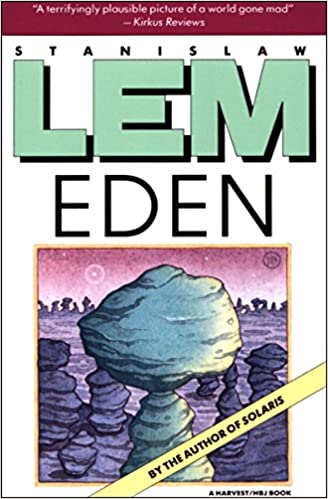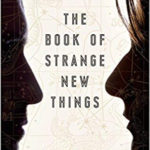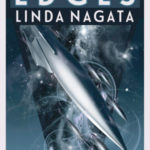Is understanding the alien even possible for the human mind? That is the question posed by Stanisław Lem‘s Eden, a 1958 novel translated by Marc E. Heine for publication in English in 1989. And has anyone ever had a more exuberant imagination than this great Polish writer in presenting baffling alien civilizations for humans to try to decipher?
This is the third of Lem’s novels I’ve read, the other two being Solaris and The Invincible. All were written in a six-year period, and all focus on differing efforts to understand alien minds, speech and fundamental nature.

None of these expeditions to fictional planets succeed because, Lem suggests, there is something fundamentally impossible about bending the human mind with all its preconceptions to fit the drastically different conditions of alien civilizations. But few writers have as much fun and dramatic flare presenting his human crews as they struggle with things they cannot understand. And understanding the alien is always out of reach, no matter how many theories they devise, corpses they dissect, observations they make or battles they fight.
Eden begins like a classical story in the middle of things as a huge white spaceship crash lands on an unexplored planet, burying its main hatch underground, wrecking multiple onboard systems, flooding the reactor engine room, shorting most electricity and hence all the robotic workers. They are truly stuck and first have to use their wits just to find a way out of the ship and begin to repair all the damage.
The crew of six, known mostly by their titles (Captain, Physicist, Doctor, Engineer, Cyberneticist, Chemist), and all men, come alive in their professional roles as they grapple with one technical problem after another. Lem is meticulous in describing the multiple repairs the crew make to the ship, though the technology is pretty outdated. They fix robots with transistors and charge up small atomic “throwers” that require lead shielding. There are few computers, and one that plays an important role late in the story is a massive box with squawky speakers.
It’s the intensity of the crew’s many arguments on what to do that I found especially involving. They debate everything about strategies in facing the unknowns of Eden, the need for weapons, the ethics of dealing with aliens and struggles to understand their observations. And they encounter endless strange sights.
Soon after digging their way out the main hatch, they get a jeep operational and make multiple excursions, choosing a different compass direction each time.
They run into stands of tall plant-like stalks that startle at their actions and disappear into the ground. There are tree-like structures with cocoon appendages that seem to breath. There are clusters of tall chimneys that shoot geysers of dark gases into the sky. They encounter something that resembles a factory but seems to dismantle the bizarre objects it produces.
They come upon a great cluster of dirt mounds with dead bodies floating inside, then a prison-like enclosure filled with aliens who almost trample them out of fear. And they have several close encounters with other aliens, especially when one finds its way on board. It is a huge, hulking, sack-like mass, and as they turn it over, after sedating the thing, here is what they see:
As from a gigantic, elongated oyster, a small two-armed trunk emerged between the thick, fleshy folds that closed winglike around it; dangling, its knotty fingers touched the floor. The thing, no bigger than a child’s head, swayed back and forth, slower and slower, suspended from pale-yellow ligament membranes, until finally it came to rest. The Doctor was the first to pluck up the courage to approach it. He grasped the end of a limp, multijointed arm, and the small veined torso turned, revealing a flat, eyeless face with gaping nostrils and something jagged, like a tongue bitten in two, in the place where a man’s mouth would be. “An inhabitant of Eden…” whispered the Chemist.
Eden, Kindle edition, Location 790
The crew come to call these creatures “doublers” because of this child size body that emerges from the larger ones. Though they encounter other doublers, usually at a distance, a second, more intelligent one comes on board later in the story. It is this one that the crew attempt to communicate with through the computer, but that turns out to be a frustrating experience.
At one point, the Doctor summarizes the basic problem they face in trying to understand the nature of Eden and its inhabitants.
“Being human, we make associations and interpretations that are human, we apply human laws, arrange facts into patterns brought from Earth. I am absolutely certain that we all thought the same thing this morning: that we had come upon the grave of victims of violence, of murder. But we don’t really know….”
Eden, Kindle edition, Location 1216
Each discovery they make, described in clear, often beautiful detail, seems ambiguous. Was that encounter an attack or was it an effort to communicate? Was that a factory or a structure created for some unknown purpose? Was that a wall meant to pen them in as prisoners or a barrier to protect the natives from these invaders?
Lem is fascinated at the endless curiosity and inventiveness of humans to come up with explanations for phenomena they cannot fully explain. In Solaris he created a whole bibliography of planetary studies, complete with a long history of scientific disputes, yet in the end even first-hand exposure to the effects of Solaris fails to clarify the nature of the vast alien entity.
Unlike that novel, the explorers of Eden travel many miles in their jeep and an armored vehicle on the ground, behold one amazing sight after another, yet they can never be sure how to interpret what they see. It is a fascinating and intense journey well worth taking with them. While Eden is a relatively short novel, it is packed with more graphically realized detail than many longer books. I highly recommend it as a good starting point for Lem’s extensive list of works.




Leave a Reply